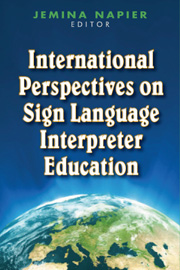Jemina Napier, Editor
|
View the table of contents. View the list of contributors. Read an excerpt. Read a review. |
$75.00s print edition $75.00 e-book |
Interpreter Education, Volume 4
From Interpreting, International Journal of Research and Practice in Interpreting
This volume, edited by Jemina Napier, is the fourth and latest addition to the Interpreter Education Series (edited by Cynthia B. Roy) on sign language interpreter training. The provision of formal training in sign language interpreting (SLI) began in a handful of countries in the 1960s and in many others, it began much later (or has yet to begin). Worldwide prior to this, ‘interpreters’ in the form of the hearing friends and relatives of deaf individuals mediated linguistically a necessary practice since the dawn of time when mankind first learnt to utter comprehensible speech. Over the past fifty years, sign language (SL) interpreter training programmes have developed all over the world in response to a growing demand for qualified interpreters able to assist deaf people in a wide variety of social contexts. Some training institutions can now offer and share several decades of experience in the field, whereas others are still at early stages of development or planning. Internationally, many obstacles to the provision of SL interpreter training still remain, often the consequence of national linguistic policies and political shortsightedness leading to the heterogeneous development of many different kinds of educational institutions and approaches. This volume provides an extremely informative overview of the present situation (up to 2008) by focusing on interpreter education in a selection of fifteen countries across five continents. The continental balance, however, is somewhat uneven, with most emphasis placed on European countries (seven contributions), followed by Asia-Pacific countries (four), the Americas (three) and only one from Africa. Although the volume indeed offers a wide range of international perspectives, the addition of reports on the situations in China, India, Russia, and a few more Latin American and African countries, such as South Africa, would have given a more complete picture of the provision of or lack of SL interpreter education in our modern world.
In the Preface Carolyn Ball, Treasurer and former President of the Conference of Interpreter Trainers (U.S.A.), outlines the early history of interpreter education in the United States followed by the Foreword by Liz Scott Gibson, President of the World Association of Sign Language Interpreters, who emphasises the need to share information and resources in the field of SLI and to form collaborative relationships between countries. There is no introduction by Jemina Napier (editor) to introduce the collection of papers, nor is a postscript provided. Bibliographic references are added to each chapter rather than in a single grouping at the end.
Part one on SLI in Europe begins with an overview by Nadja Grbić of its development in Austria since the 1990s. A full-time SL interpreter training course within the regular translator and interpreter programmes began at the University of Graz in 2002 following the Bologna Process in European higher education (Bologna Declaration of June 1999). Details are provided both of the Graz course, which is integrated with training in a spoken language, and of the development of the Austrian Association of Sign Language Interpreters (ÖGSDV) and its subsequent involvement as advisor in a private interpreter training programme in Linz. Grbić touches on problems to he addressed in the future, such as a high dropout rate among SLI students (as many beginners are probably unaware of the cognitive, social and emotional tasks involved) and the training of trainers, both deaf and hearing. A promising area of future growth is training of deaf translators in the translation of websites into signed languages.
Marjukka Nisula and Juha Manunen provide a Finnish contribution with a detailed description of three training programmes at universities of applied sciences, again within the Bologna Process. From the 1 960s, piecemeal SL interpreter training was offered by the Finnish Association for the Deaf and later the Finnish Ministry of Education, but since the 1990s it has become well organized with the addition of a personal study programme providing regular counselling at private and group level. One of the greatest challenges is keeping abreast of the growing need for interpreter skills in academic SL as more deaf people are participating in higher education.
Jemina Napier is a professor and chair of Intercultural Communication in the Department of Languages and Intercultural Studies at Heriot-Watt University in Scotland.
Print Edition: ISBN 978-1-56368-411-1, 6 x 9 casebound, 328 pages, 7 tables, 16 figures, appendices
$75.00s
E-Book: ISBN 978-1-56368-458-6
$75.00
To order by mail, print our Order Form or call:TEL 1-800-621-2736; (773) 568-1550 8 am - 5 pm CST
TTY 1-888-630-9347
FAX 1-800-621-8476; (773) 660-2235
